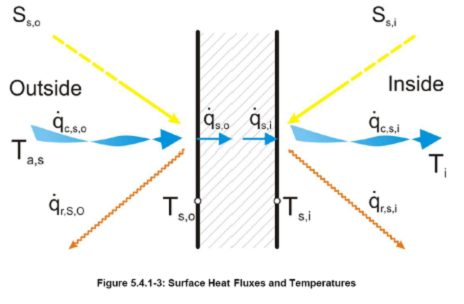Dear Adnan,
the input Tsky is used for longwave radiational exchange. Your approach seems fine to me.
Best
Jakob
_________________________________________________________________________________________________
Jakob Merk
TRNSYS Software Team
Transsolar Energietechnik GmbH
Curiestraße 2
70563 Stuttgart
Fax: +49 711 67976-11
Email: hotline@transsolar.com
Web: www.trnsys.de
Von: TRNSYS-users [mailto:trnsys-users-bounces@lists.onebuilding.org]
Im Auftrag von adnan rasheed
Gesendet: Donnerstag, 21. April 2016 16:18
An: TRNSYS users mailing list at OneBuilding.org
Betreff: Re: [TRNSYS-users] Uvalue
hi,
Thanks jakob you suggest me NTYPE 19.. to ..22 .i tried sum of N-types 19 and 20. and get desired trend of the u value as i change the required heating temperatures 2, 4, 6, 8, 10, 20, 30, 40, and 50.
if i am not wrong these ntypes are radiative and convective heat losses??? through the window .
but the problem is that i want to simulate at sky temp 0 and then -20, as my simulation is only for 4 hrs in night time from 1 am to 5 am. i want to simulate night sky radiation effect on heating requirement by using 0 and -20 fix sky temperature.
i use 0 and -20 sky temp in equation and connect it to type 56 as tsky am i right here???
Best regards
Adnan
On Wed, Apr 20, 2016 at 11:22 PM, hotline <hotline@transsolar.com> wrote:
Dear Adnan,
please make sure that all other heat transfer effects (solar radiation, internal gains,
convection, infiltration) besides heat flow through walls are switched off!
you can use NType 19…22 to determine the heat flows at the front and back side of the
wall. And please keep in mind that TRNSYS will simulate capacitive effects, too.
|
|
Best
Jakob
_________________________________________________________________________________________________
Jakob Merk
TRNSYS Software Team
Transsolar Energietechnik GmbH
Curiestraße 2
70563 Stuttgart
Fax: +49 711 67976-11
Email: hotline@transsolar.com
Web: www.trnsys.de
Von: TRNSYS-users
[mailto:trnsys-users-bounces@lists.onebuilding.org]
Im Auftrag von Adnan Upm Spain
Gesendet: Mittwoch, 20. April 2016 16:07
An: TRNSYS users mailing list at OneBuilding.org
Betreff: Re: [TRNSYS-users] Uvalue
Thanks Merk for your reply...
I am using Ntype2 sensible heating demand and one out put Ntype 906 which give energy balance in it system also gives same value for heating.
Regards
Adnan
Sent from my Sony Xperia™ smartphone
---- hotline wrote ----
Dear Adnan,
your approach makes sense to me. TRNSYS does calculate heat transport for each time
step and is not using a fixed U-Value.
Which TRNSYS outputs did use for
q= convective and radiative heat loss ?
I guess that using a wrong output could have coused your problem…
Sincerely yours
Jakob Merk
_________________________________________________________________________________________________
Jakob Merk
TRNSYS Software Team
Transsolar Energietechnik GmbH
Curiestraße 2
70563 Stuttgart
Fax: +49 711 67976-11
Email: hotline@transsolar.com
Web: www.trnsys.de
Von: TRNSYS-users
[mailto:trnsys-users-bounces@lists.onebuilding.org]
Im Auftrag von adnan rasheed
Gesendet: Mittwoch, 20. April 2016 13:13
An: trnsys-users@lists.onebuilding.org
Betreff: [TRNSYS-users] Uvalue
hi everyone,
i have one question i am stuck with this problem.
1- i want heating a room having one window, by using type 56
inside temp = 10, 20, 30,....
dry bulk temp= ambient temp = outside = 0
sky temp = 0 and -20
i wanna see the change in overall heat transfer coefficient = u-value of glazing (window) by changing inside temperature using this equation
U = Q / A(T) where
U = U-value
q= convective and radiative heat loss
A = Area of window
T = ambient and inside temp difference.
i get results but TRNSYS giving me almost the same value of U for all temp difference. trend is not same as experimental U-value trend according to change in
inside temp.
anyone please help me with this is it possible to calculate U-value of window like this. or trnsys use fix U-value for the calculation of heat load.
thanks in advance. for killing your time.
Regards
Adnan
_______________________________________________
TRNSYS-users mailing list
TRNSYS-users@lists.onebuilding.org
http://lists.onebuilding.org/listinfo.cgi/trnsys-users-onebuilding.org
